When I found out Daisy’s younger sister Steph was staying overnight at our house on Saturday after taking their father to the airport I was happy. Not just to see Steph, though she is fun to hang out with, but because I figured that she tends to sleep late, which meant that I might have the opportunity to borrow her car and go to Jones Beach and check out the birds. Turns out I was right!
It was 6 AM when I arrived at the West End, early enough that I didn’t have to pay admission to Jones Beach State Park. My first stop, as it almost is at Jones Beach, was the Coast Guard Station, where I scoped out the sandbar and was amazed by the sheer number of birds. I managed to count 245 American Oystercatchers and at least 30 Red Knots! Of course, they weren’t the only shorebirds around: Black-bellied and Semipalmated Plovers were around in numbers as were Short-billed Dowitchers, Willets, Least and Semipalmated Sandpipers, and lesser numbers of Ruddy Turnstones.
Ruddy Turnstone in flight
And while I greatly appreciated the early morning light on the shorebirds I was also fascinated by the hordes of jellyfish that were swimming around the dock, something I had never seen before at Jones Beach. There were two types, both pictured below. Being an upstate New York native I really have no experience with jellyfish and therefore have no idea what species they are. Can anyone help?
After watching and photographing the jellyfish for awhile boats started arriving at the dock. The shorebirds noticed and started to make themselves scarce. I figured I would as well, and decided to walk the brushy edges to see if any migrant passerines were present. I didn’t get far because hordes of bloodthirsty mosquitoes drove me back to the car, bloody and itchy. So rather than walking the edges I drove over to West End 2 to see if the grassy swale there might yield any good “grasspipers” like Baird’s or Buff-breasted Sandpipers as it did last year. En route, I spotted a Killdeer.
The grasspipers were not present but lots of peeps were. Mostly Least Sandpipers and Semipalmated Plovers were foraging and resting in the swale and hundreds of Sanderlings were roosting on the beach. Rather than exhaust myself with the long walk to the jetty and flush all of the tired shorebirds on the way I just sat down and watched the waves for awhile, to say nothing of the Common Terns and gulls.
Though I didn’t find any rarities or any new birds for the year it was an all-around wonderful time to myself. I didn’t speak to a single person in the two-plus hours I spent wandering around and saw some stuff that will stick in my mind for awhile. Not only that, but the sunrise was nice too…

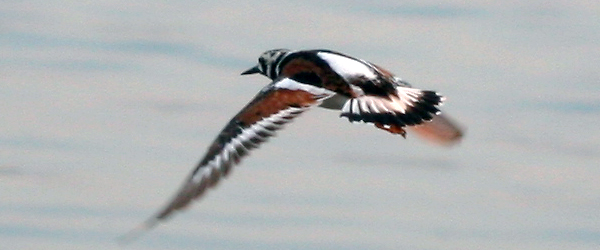
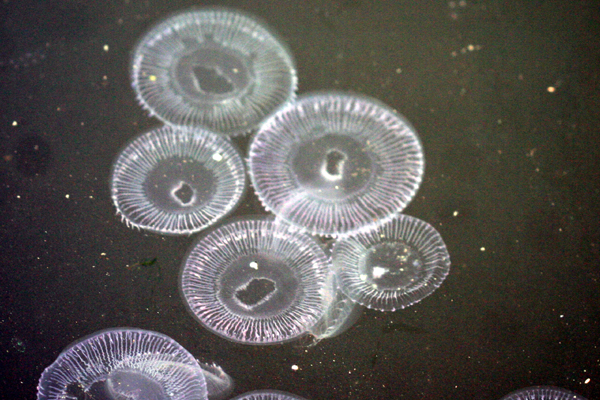
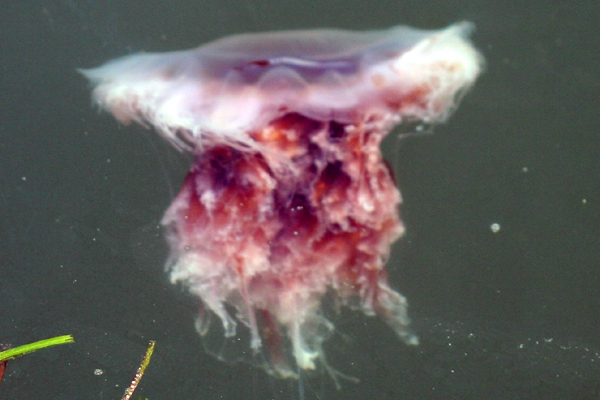
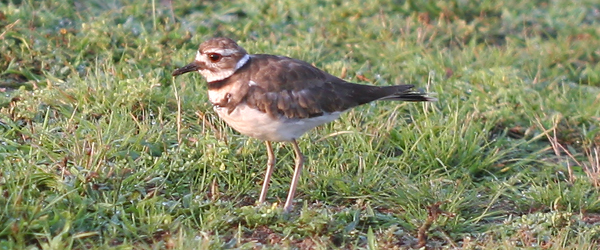
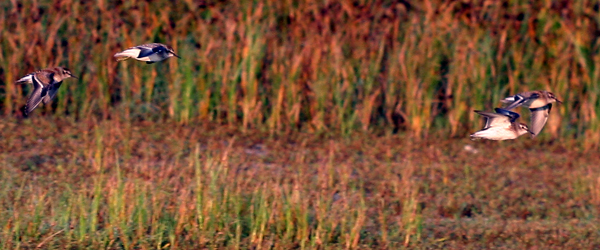
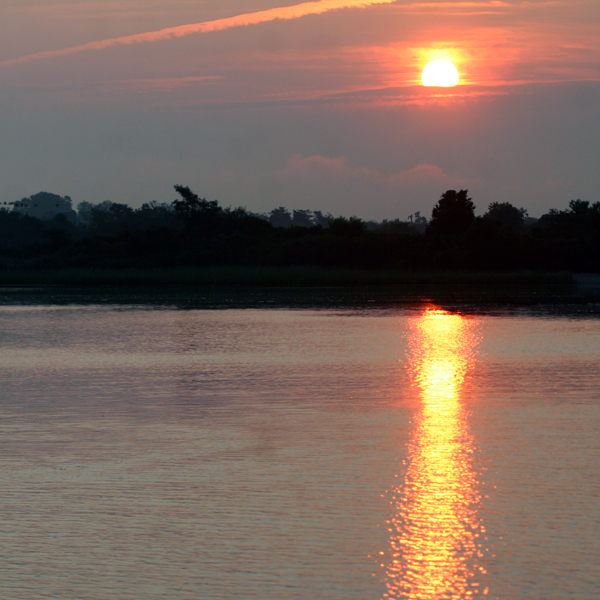










I’ve seen the second, bigger jellyfish off the coast of North Carolina as well, they must be all along the Atlantic coast.
I think it’s either a Cannonball Jelly in the Stomolophus genus or a Mushroom Jelly in Rhopilema. I can’t see the bell well enough to tell. One apparently has a brown stripe around the bottom, but they both have that chunky looking thing underneath instead of tentacles.
Nice post! I always enjoy seeing posts from West End. I’ve had many good birds down there.
The first jellyfish is a Moon Jelly (Aurelia aurita). They are fun, and very common. The second is a Lion’s Mane Jellyfish (Cyanea capillata). They are another relatively common species (although much less numerous than Moon Jellies). They are one of the ones you don’t want to touch… they give quite a sting.
Here in the UK we’re getting ever-increasing reports of Portugese man o’ war moving into the warming coastal waters, and parts of the Mediterranean are now swarming with huge rafts of jellyfish because one of the top predators in the sea – the Tuna – has been all but fished into extinction…great eh…(nice pictures though Corey)
I concur with Shawn’s assessment of the jellyfish.
I read recently that we have been getting more species of jellyfish earlier in the summer in recent years. I think that some of them have been moving their ranges up the coast.
I’m with Shawn and Patrick on the IDs. I don’t think the early arrival means they’re expanding their range though. Jellyfish are kind of like some of the irruptive species of birds. Some years there are “blooms” of jellyfish. The explanations I’ve seen for this year’s bloom is the south winds pushing the warmer surface water away and allowing the cold water upwelling to occur. Lion’s manes in particular like cold water. Both of these species can occur up here in Massachusetts between May and October but August is generally the peak.
The NYT article also mentioned sewage spills and other sources of nutrients as a possible cause. Once guy it quotes as saying he’s seen roughly 5 year cycles of jellyfish blooms.
I stand corrected on the big jelly, but the first ones don’t look like Moon Jellies to me. They lack the clover-leaf pattern on the center of the bell.
I think they’re more likely to be some sort of hydromeduae. Check out the bottom example on this website.
Shawn, Patrick, Janet, and Nate: Thanks for the help identifying the jellyfish.
Charlie, John, Janet: I suppose we’ll never know why these particular jellyfish showed up where they did but I don’t think that there is any doubt that some jellyfish congregations in odd spots are because of man-made environmental issues…
That’s kind of you Corey as my help was worthless. : )
Perhaps I should stick to the birds…
Not at all Nate, I think you were spot on on your second comment (which for some reason hadn’t shown up when I last commented)…but I don’t know enough to know for sure…
10000jellyfish.com is probably available…
I have been swimming on East Atlantic Beach, NY for years and I have never encountered the Lion’s Mane until this year. They have been in the ocean all summer and it is almost unbearable to swim amongst them. The sting is painful and annoying. Are they here to stay?
On another note, I was on the same beach with my friend yesterday and medical waste was all along the shoreline. I even found a disgusting bottle of clotting blood along with hypodermic needle wrappers and EKG pads. There was a plastic urine specimen bottle. We collected as much of this waste as possible and placed it into a plastic bag. We took it to the police we the hopes that they could trace where this medical debris came from. Unfortunately we found out this morning that the waste was disposed of with no investigation. It is very unsettling to think that our children can possibly be exposed to these bottles of blood while playing on the beach.
We were on Fire Island this week, where we saw a huge number of dead jelly fish which at first glance looked like glass shard and beer-bottle bottoms washed up on the sand. They looked like clear glass but felt like soft rubber. The beer-bottle gottoms were about 3″ in diameter with no tentacles, perhaps broken off.
Locals reported that these jellyfish were present all season, though they did not sting. They said they were often washed up, but that perhaps the large numbers we witnessed were indicative of end-of-season die off. This string of messages was most interesting, but if it’s not a Moon jelly fish because of its clover pattern, where do we go from here?
the second jellyfish is a portugese man-o-war, they are in ny whenever there is bad weather in the southern reigons
While visiting Fire Island last fall, I saw lots of fragmites, the invasive marsh grass. Anyone have any idea how widespreaad it’s become?
Burnell
Ive also swam in NY waters for close to 20 years, the lions mane is very common, we see it washed ashore every fall, and see them live in the spring and summer. This is not at all uncommon, at least not in the shinnecock bay.